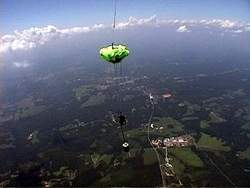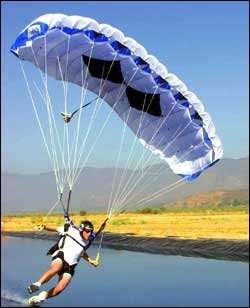Atair 'Chutes Offer Guided Autonomous Landing
 Mark Montalvo at Atair wrote us,
"...to introduce you to Atair Aerospace, Inc., an exciting
young
Mark Montalvo at Atair wrote us,
"...to introduce you to Atair Aerospace, Inc., an exciting
young
Brooklyn-based high-tech defense company that was recently honored
with the Comet Award for '2003 Manufacturer of the Year for
Innovation' by judges BAE Systems, EDO Corporation, and Northrop
Grumman. Atair has received both Phase I and Phase II SBIR (Small
Business Innovation Research) funding from the Army Natick Soldier
Center for the development of a 75lb. autonomous guided parachute
delivery system. In a recent informal conversation with Natick
officials about the SBIR process and Atair's application, Atair was
told that from the Army's Airdrop Division, Atair received the only
Phase II approval for the topic of precision airdrop this year.
Additionally, out of all the Army topics for Phase II SBIR, we were
ranked #1 and are one of their highest priorities. Atair Aerospace
is currently the only U.S. based company that has demonstrated
autonomous guided flight capabilities."
 He's justifiably happy with
the accomplishments, but he wanted us to tell you more about them.
Everything's a UAV now -- and Atair is working on a guided
parachute: Atair's proprietary technology is centered on its ONYX
System. The ONYX is a two-parachute delivery system that employs a
high efficiency elliptical parafoil for initial deployment and
guidance and a second non-guided parachute (deployed at the lowest
possible altitude) for landing.
He's justifiably happy with
the accomplishments, but he wanted us to tell you more about them.
Everything's a UAV now -- and Atair is working on a guided
parachute: Atair's proprietary technology is centered on its ONYX
System. The ONYX is a two-parachute delivery system that employs a
high efficiency elliptical parafoil for initial deployment and
guidance and a second non-guided parachute (deployed at the lowest
possible altitude) for landing.
The ONYX System can be deployed up to an altitude of 35,000 ft.
The flight computer determines its heading based on integrated GPS
and Inertial Navigation Sensors. When the system is within a
programmed distance of directly overhead of the target, it will
execute a sustained spiral dive until it reaches its minimum
pre-programmed altitude where it will transition from the guidance
parafoil to the landing parachute. The system will them fall
unguided a short distance until touchdown.
HAHO, HAHO, It's Off to War We Go...
 Recent conflicts in Iraq,
Afghanistan, and Somalia have demonstrated the critical need for
guided parachute systems to replace current, obsolete airdrop
delivery techniques. The proliferation of inexpensive
surface-to-air missiles gravely jeopardizes aircraft and personnel
flying below 25,000 feet; a significant problem, since conventional
military airdrop techniques require cargo to be released from
altitudes below 1,500 feet. Speaking with National Defense Magazine
about this problem, Edward Doucette, Director of Airdrop and Aerial
Delivery at the Army Natick Soldier Center (MA), stated that "dumb
airdrop--the way we [the Army] do it today--is at the mercy of the
wind, and accuracy is nonexistent."
Recent conflicts in Iraq,
Afghanistan, and Somalia have demonstrated the critical need for
guided parachute systems to replace current, obsolete airdrop
delivery techniques. The proliferation of inexpensive
surface-to-air missiles gravely jeopardizes aircraft and personnel
flying below 25,000 feet; a significant problem, since conventional
military airdrop techniques require cargo to be released from
altitudes below 1,500 feet. Speaking with National Defense Magazine
about this problem, Edward Doucette, Director of Airdrop and Aerial
Delivery at the Army Natick Soldier Center (MA), stated that "dumb
airdrop--the way we [the Army] do it today--is at the mercy of the
wind, and accuracy is nonexistent."
In response to the critical strategic requirements of
precision airdrop, Atair AS has developed the ONYX System. This
recoverable and reusable delivery system can be deployed from an
altitude of up to 35,000 feet and autonomously navigate its cargo
to a predetermined landing target, thus ensuring the safety of
aircraft and personnel from hostile ground-based fire.
After release from the aircraft, the ONYX System
employs an elliptical parafoil for initial deployment and guidance.
The navigation of the cargo to a predetermined landing zone is
controlled by an on-board flight computer that utilizes GPS and
Inertial Navigation Sensor technology. A second non-guided
parachute is then deployed at the lowest possible altitude for a
soft landing.
The ONYX System is unique in that its design significantly
reduces time aloft and vulnerability to wind. It is also scalable
to considerably heavier cargo weights than is feasible with other
technologies. The technological advances used to design this system
have received multiple top awards, been used to set multiple world
records in the parachute industry, and have led Atair AS to file
more than 16 patents.
 Affordable Flying Expo Announces Industry MOSAIC Town Hall
Affordable Flying Expo Announces Industry MOSAIC Town Hall Classic Aero-TV: Composite-FX Sets Elevates the Personal Helicopter Market
Classic Aero-TV: Composite-FX Sets Elevates the Personal Helicopter Market Aero-News: Quote of the Day (10.25.25)
Aero-News: Quote of the Day (10.25.25) ANN's Daily Aero-Term (10.25.25): Ground Stop (GS)
ANN's Daily Aero-Term (10.25.25): Ground Stop (GS) NTSB Final Report: Gallow Daniel A Kitfox Classic IV
NTSB Final Report: Gallow Daniel A Kitfox Classic IV





